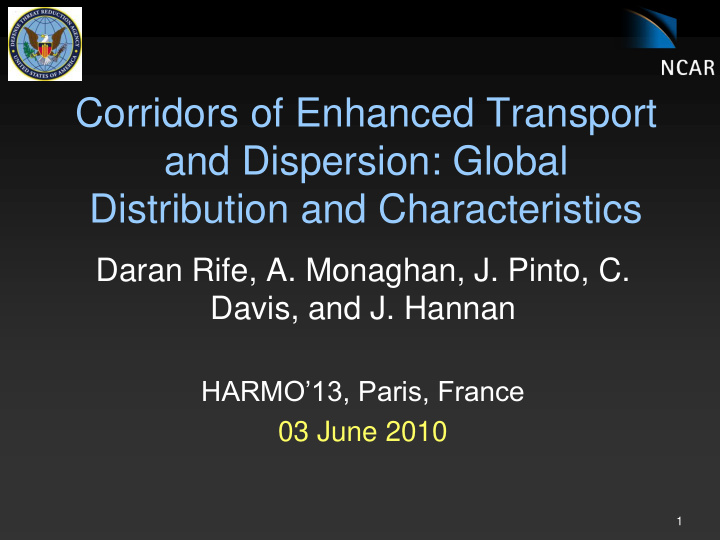



Corridors of Enhanced Transport and Dispersion: Global Distribution and Characteristics Daran Rife, A. Monaghan, J. Pinto, C. Davis, and J. Hannan HARMO’13, Paris, France 03 June 2010 1
Basis for this talk JOURNAL OF CLIMATE Global distribution and characteristics of diurnally varying low-level jets Daran L. Rife, James O. Pinto, Andrew J. Monaghan, Christopher A. Davis, and John R. Hannan (Manuscript received 04 November 2009, in final form 04 May 2010) Global precipitation extremes associated with diurnally varying low- level jets Andrew J. Monaghan, Daran L. Rife, James O. Pinto, Christopher A. Davis, and John R. Hannan (Manuscript received 04 November 2009, in final form 04 May 2010) 2
Motivation • Low-level jets (LLJs) strongly impact distribution of atmospheric constituents originating from Earth’s surface and human activity. • Document phenomenology of low-level jets in various environments. 3
Mechanisms for LLJs • Diurnally varying eddy viscosity driven by changes in solar heating. • Changes in horizontal baroclinicity arising from spatial contrasts in heating. 4
Global mesoscale analysis • 21-year global downscaled reanalysis – 1985-2005 – 40 km grid. – 12 vertical layers in lowest 1.5 km AGL. – Hourly three-dimensional output to fully resolve diurnal cycle. • Performed with MM5- and WRF-based climate downscaling system. • Assimilated high-quality observational datasets. 5
NCAR Climate FDDA system (ClimoFDDA) global analysis regional analysis WRF + Post-processing Year 1 FDDA observations Mean global analysis regional analysis Variance WRF + Year 2 FDDA Probability Est. observations Extremes global analysis regional analysis WRF + ―Typical‖ day Year 3 FDDA observations Input to Decision global analysis regional Support Tools WRF + analysis Year N FDDA observations MM5-based version used 6
Mapping corridors of enhanced T&D • Each hourly output assigned the local time within each 15 ° longitudinal strip on the globe. — Example: 100 ° W at 0600 UTC assigned time of 0000 LT. 7
Mapping corridors of enhanced T&D • Each hourly output assigned the local time within each 15 ° longitudinal strip on the globe. — Example: 100 ° W at 0600 UTC assigned time of 0000 LT. • NLLJ index based on diurnal change in wind’s vertical profile. — Do winds conform to a jet-like profile? Jet level winds (500 m AGL) at midnight stronger than those aloft (4 km AGL). — Is jet nocturnal? Jet level winds (500 m AGL) at midnight stronger than at noon. 8
Mapping corridors of enhanced T&D • Each hourly output assigned the local time within each 15 ° longitudinal strip on the globe. — Example: 100 ° W at 0600 UTC assigned time of 0000 LT. • NLLJ index based on diurnal change in wind’s vertical profile. — Do winds conform to a jet-like profile? Jet level winds (500 m AGL) at midnight stronger than those aloft (4 km AGL). — Is jet nocturnal? Jet level winds (500 m AGL) at midnight stronger than at noon. • Result: 21-year database of daily NNLJ index values for every point on globe. 9
First objective maps of recurring LLJs Colors = 21-yr mean NLLJ index. Arrows = Mean 500- m-AGL winds at local midnight, plotted every 20 th grid point. 10
NLLJ characteristics 1985-2005 Vertical, dotted black lines mark Bonner (1968) wind speed classes. 11
Diurnal variations in NLLJs 1985-2005 12
Detailed study: Tarim Pendi NLLJ Strongest 10% LLJ events 1985-2005. Occurs in boreal summer; very episodic. Forms following cold frontal passages around Tian Shan mountains to the north. 13
Detailed study: Ethiopia NLLJ Strongest 10% LLJ events 1985-2005. One of only three that occur in winter. Results from formation of a cyclonic lee vortex on the west side of the Ethiopian Highlands. 14
Summary and commentary • NLLJs are ubiquitous within world’s land covered areas and strongly drive the regional T&D. — Mesoscale through synoptic-scale in extent. — Produce coherent transport over hundreds of kilometers. • Remain a fundamental challenge to global weather and climate modeling of atmospheric constituents. — Shallow and intense. — Arise partly from variations in turbulence. 15
16
17
Independent verification of re-analysis: Diurnal and vertical structure of PBL None of the 36 stations assimilated by ClimoFDDA or driving NCEP-DOE Reanalysis Neligh, NE Fairbury, NE Hillsboro, KS Lamont, OK Purcell, OK Composite 5 stations along the climatographic axis of the North American low level jet (LLJ). 18
Mean time-height of meridional winds for Great Plains LLJ Oranges = southward Blues = northward LLJ From Rife et al. (2010), Journal of Climate 19
Recommend
More recommend